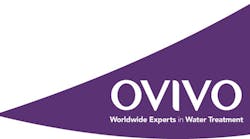A historic change in how membrane bioreactor (MBR) wastewater treatment plants are designed, built and operated is on display at the Pembroke, Mass., Wastewater Treatment Facility (WWTF). Serving several commercial establishments, this innovative WWTF incorporates simultaneous nitrification denitrification, high mixed liquor suspended solids (MLSS) (20,000 mg/L) and concentrated oxygen all in a single-stage process designed to produce reuse-quality effluent with a total nitrogen (TN) concentration of less than 7 mg/L.
The wastewater treatment system is permitted under the Massachusetts Ground Water Discharge Standards of Treatment, consisting of a maximum daily flow of 40,000 gal per day; effluent biochemical oxygen demand (BOD) of less than 30 mg/L; total suspended solids (TSS) of less than 30 mg/L; and TN of less than 10 mg/L. Prior to the plant being retrofitted with single-stage MBR technology, the facility consisted of three parallel trains containing media-based trickling filters. The filters, which had been in operation for only five years, were unable to meet the TN limits, resulting in the Massachusetts Department of Environmental Protection issuing an Administrative Consent Order to upgrade treatment at the facility.
Challenged by a limited budget, the facilities engineer had to search for alternative treatment technologies while using as much of the existing infrastructure as possible. After careful consideration and review of many possible technologies, the decision was made to implement a high-rate, single-stage MBR.
The total cost to retrofit the facility was just more than $900,000. The facility was reconstructed in four months by maximizing the use of existing infrastructure, including the equipment building, effluent storage tanks and pretreatment tankage, which were repurposed for equalization and sludge holding. A new precast tank was brought in for the single-stage process zone, which contains the submerged membranes.
In operation now for nine months, the plant has been consistently providing effluent quality of BOD less than 3 mg/L; TSS less than 2 mg/L; and TN less than 7 mg/L—well below the permit requirements.
MBR Advantages
MBR technology allows for process intensification, which is the principle behind the design and operation of this facility. Activated sludge processes are intensified as the concentration of active biomass is increased and, proportionally, process volume is decreased. Using membranes instead of sedimentation to remove solids allows for concentrations three to five times higher than conventional technologies.
Further intensification, however, is primarily limited by the oxygen uptake rate (OTR) required for the biological process. OTR is a function of oxygen saturation, which is about 10 ppm at ambient conditions, and diffuser performance. Supersaturating a slip stream with the use of concentrated oxygen overcomes these limitations and can increase treatment capacity by a factor of 25% to 50%, depending on site/process conditions
(e.g., food-to-mass ratio). Typically, conventional activated sludge plants run at MLSS concentrations of about 3,000 mg/L,
and conventional MBR plants run at 10,000 mg/L when optimized for energy and given diffuser performance limitations at higher solids concentrations. The preferred range of MLSS concentrations for the high-rate, single-stage system is 20,000 to 30,000 mg/L.
High-rate, single-stage MBR solutions offer some advantages over
conventional options:
- • They drastically reduce system footprint requirements.
- • They allow for increased plant capacity within the existing infrastructure.
- • They provide increased system simplicity and reliability while driving down total installed cost.
- • They maximize turndown capabilities, thereby reducing the high energy typically found during low-flow conditions.
By utilizing high-rate MBR technology, municipalities and private companies can reduce upfront capital costs, decrease long-term operating expenses and accommodate future permit limits—all in a single-tank design. The Pembroke WWTF is an example of how the best available treatment technology also can be the most cost-effective solution to a wastewater treatment problem.
Download: Here



